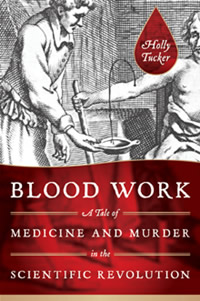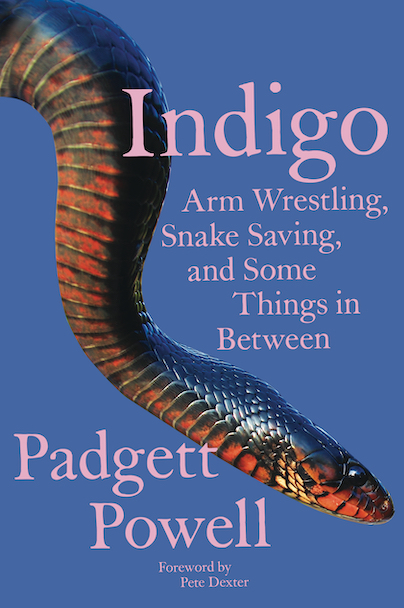Hot Blooded
Nashville author Holly Tucker explores the fascinating history of blood transfusion
In the seventeenth century, most “knowledge” of the human body and its workings came from Aristotle, Galen, and a few contemporary philosophers like René Descartes. All agreed that illness sprang from an imbalance of the four “humors” that infused living things. Details of the functions of organs and blood were “proved” via well-constructed arguments, rather than direct observation or experimentation. It was a time when astronomers were first and foremost astrologers, and those who studied physics or chemistry did so primarily to improve their skill in alchemy. Yet it was also an age of stunning, actual discovery, of the birth of what we now regard as “scientific method.” Scientific debates were closely followed by monarchs and their courts; those who made discoveries gained passage to the highest levels of European society. In her fascinating new history, Blood Work: A Tale of Medicine and Murder in the Scientific Revolution, Vanderbilt associate professor Holly Tucker brings to life this highly charged and sometimes dangerously ignorant world.
The “murder” of the subtitle is a failed experiment in human blood transfusion by a young French physician named Jean-Baptiste Denis. This 1667 experiment was the culmination of a pitched scientific battle that ran for several years between English and French researchers (at a time when their countries’ navies were simultaneously pitching cannon balls at one another) to uncover the true nature of blood and its circulation. The experimentation had been prompted by the English researcher William Harvey’s stunning—but still widely doubted—discovery in 1628 that blood re-circulated through the body, rather than being produced by the liver and consumed by the heart, as in classical models. In the decades following Harvey’s discovery, researchers transferred blood between animals, across species, and ultimately into and out of humans in increasingly creative—if often cruel—ways. Fueled by new scientific journals that touted success any time a test subject survived, the experimentation reached a fever state on both sides of the English Channel during the 1660s.
 The death of Denis’s test subject, and the resulting murder trial, effectively ended “scientific” attempts at transfusion for the next 150 years. But the little-known period when it was at its height proves a rich subject for Tucker, whose exhaustive research not only lays bare the experiments scientists performed, but also the cultural mindset that allowed the progenitors of modern medicine to perform horrific acts with few misgivings.
The death of Denis’s test subject, and the resulting murder trial, effectively ended “scientific” attempts at transfusion for the next 150 years. But the little-known period when it was at its height proves a rich subject for Tucker, whose exhaustive research not only lays bare the experiments scientists performed, but also the cultural mindset that allowed the progenitors of modern medicine to perform horrific acts with few misgivings.
“The animosities surrounding blood transfusion were not simply a matter of scientific rivalries; they were one more piece of an increasingly complex political puzzle,” Tucker writes. “The globe was ever-expanding in this age of scientific and cultural exploration, and the ports of each of the major European countries—France, England, Holland and Spain—teemed with activity as ships set off to stake claims on portions of the world that had only recently been discovered.” There was a sense of nationalistic purpose in the competing camps of transfusionists, as they were called, not unlike that of scientists engaged in the “space race” between the United States and the Soviet Union some 300 years later.
Amid the national ambitions were a great many personal ones, as well. Denis’s own patron, Henri-Louis Habert de Montmor, lured scientists into his lavish estate with private feasts and the promise of well-equipped salons, so that he might keep and display them along with his peacocks. Then there was Henry Oldenburg, the German-born, polyglot secretary of the English Royal Society who maintained a daily level of correspondence that would have been impressive even in an age of email. As the editor of the Society’s Philosophical Transactions, Oldenburg translated French experiments into English and vice versa, fueling international rivalry and placing himself squarely in the center of several controversies (eventually landing in the Tower of London for two months). In becoming an indispensible facilitator for debate among distant researchers, he created a role for scientific journals that thrives today.
 Yet among the many ambitious figures Tucker introduces, none was more ambitious than the cock-sure Denis, the son of a maker of water pumps, who saw medicine as his ticket to the nobility. There was ghoulish fascination with public dissection among educated Europeans at the time, and Denis first came to prominence as a deft dissectionist, performing for medical students in his small Paris home with cadavers placed on the dining room table. When Denis decided to best the English in transfusion, he first set out to learn the intricacies of the cardiovascular system by performing a dissection in front of a paying audience. “Assisting Denis,” Tucker writes, “the surgeon Emmerez rolled his sleeves up above the elbow and fastened a rust-stained apron around his waist. The cadaver had been gutted nearly as soon as it had been brought into Denis’ home, the entrails tossed into the nearby river; the softest organs were always the first to rot. Emmerez reached into the open cavity, pushing and probing body parts as Denis narrated the path of blood that had once flowed through the dead man’s body.” He described Harvey’s propositions on the circulation of blood, and demonstrated the one-way nature of valves in the veins with the tip of his knife. The show was a hit, and led to ever-more-crowded venues for his increasingly daring demonstrations of transfusion, first between living animals, then from animals to humans.
Yet among the many ambitious figures Tucker introduces, none was more ambitious than the cock-sure Denis, the son of a maker of water pumps, who saw medicine as his ticket to the nobility. There was ghoulish fascination with public dissection among educated Europeans at the time, and Denis first came to prominence as a deft dissectionist, performing for medical students in his small Paris home with cadavers placed on the dining room table. When Denis decided to best the English in transfusion, he first set out to learn the intricacies of the cardiovascular system by performing a dissection in front of a paying audience. “Assisting Denis,” Tucker writes, “the surgeon Emmerez rolled his sleeves up above the elbow and fastened a rust-stained apron around his waist. The cadaver had been gutted nearly as soon as it had been brought into Denis’ home, the entrails tossed into the nearby river; the softest organs were always the first to rot. Emmerez reached into the open cavity, pushing and probing body parts as Denis narrated the path of blood that had once flowed through the dead man’s body.” He described Harvey’s propositions on the circulation of blood, and demonstrated the one-way nature of valves in the veins with the tip of his knife. The show was a hit, and led to ever-more-crowded venues for his increasingly daring demonstrations of transfusion, first between living animals, then from animals to humans.
Modern readers, familiar with notions of sepsis and blood types, will understand that this tale can come to no good end, even as they read about the few lucky successes that drove Denis forward. When tragedy strikes, Denis’s ambition is undone. But his trial and eventual acquittal allow Tucker to show how petty personal and national rivalries eventually affected the broader course of science—and may continue to affect it today. In the end, the characters portrayed in Blood Work are not so disturbing because of their differences from modern medical researchers, but because of their uncomfortable similarities.
To read Chapter 16’s interview with Holly Tucker, click here.
Holly Tucker will discuss and sign copies of Blood Work: A Tale of Medicine and Murder in the Scientific Revolution on March 2 at 11:30 a.m. in the main Nashville Public Library. The event is part of the Thinking Out of the (Lunch) Box series, a joint venture of Vanderbilt University and the Nashville Public Library. At 11:30 a.m., lunch is served. At noon, the program begins. The event is free and open to the public.


